|
|
|
 |
PAKISTAN |
 |
|
|
| Tourmaline from Estaknala, located at the foot of Haramosh mount, 7 kms from Sassi. (Between Gilgit and Skardu) |
|
The Northern areas conceals treasures, such of rubies, emeralds, sapphires, aquamarines, topazes, tourmalines etc. Unfortunately, their extraction directly in the bed-rock, makes the exploitation very difficult. |
 |
|
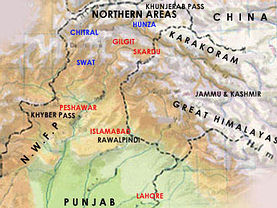 |
| Emeralds from Sassi found in a limestone.
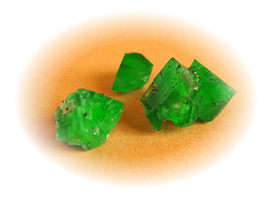
|
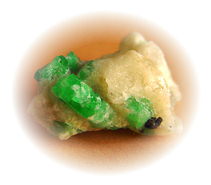 |
| |
|
 A gravel-top 241 kms road track connects Gilgit to Skardu, the capital of Baltistan perched 2438 meters above sea level. The journey takes 6 to 8 hours. Sassi is located at the edge of this road, in the geological belt made up amongst other things of amphibolites surrounding Nanga Parbat, one of the famous peaks of the Himalayas. A gravel-top 241 kms road track connects Gilgit to Skardu, the capital of Baltistan perched 2438 meters above sea level. The journey takes 6 to 8 hours. Sassi is located at the edge of this road, in the geological belt made up amongst other things of amphibolites surrounding Nanga Parbat, one of the famous peaks of the Himalayas.
|
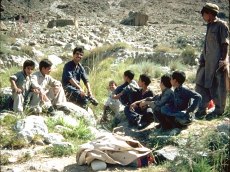 |
| Nanga Parbat - Haramosh Geological Maps |
In Sassi, life is hard, but the inhabitants are friendly. |
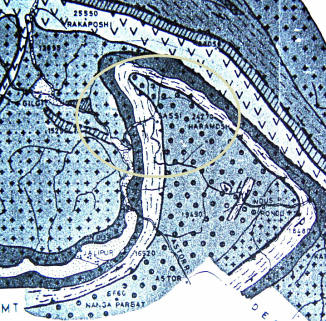 |
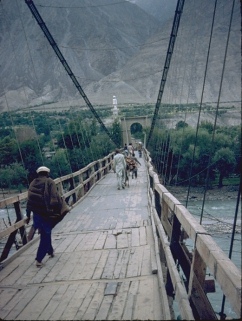 |
|
| At an elevation of 1,454 meters lies Gilgit. |
| This wood bridge is one of the longest of the |
 The Rakaposhi Volcanic Complex previously called the greenstone complex covers a large part of the Hunza Valley.Four main lithological elements comprising the whole mass: 1 basalt-andesite-dacite-rhyodacite to rhyolite. 2 greenschists, actinolite,chlorite schists, hornblend schist, amphibolite and agglomerates 3 Medium crystalline limestone and marble, quartzite, chert, slates and micaschist. 4 The igneous intrusions are mostly in the form of acid and basic sills and dykes. Leucocratic granites bodies are quite common. The Rakaposhi Volcanic Complex previously called the greenstone complex covers a large part of the Hunza Valley.Four main lithological elements comprising the whole mass: 1 basalt-andesite-dacite-rhyodacite to rhyolite. 2 greenschists, actinolite,chlorite schists, hornblend schist, amphibolite and agglomerates 3 Medium crystalline limestone and marble, quartzite, chert, slates and micaschist. 4 The igneous intrusions are mostly in the form of acid and basic sills and dykes. Leucocratic granites bodies are quite common.
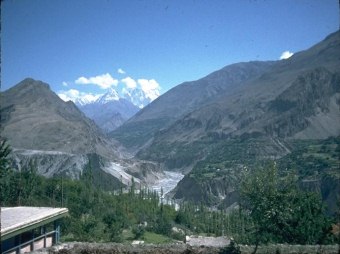
|
| Himalayas. |
| |
| Rakaposhi overview from Aliabad. |
· Valley of Hunza. 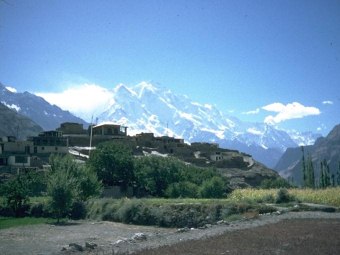 |
|
|
|
|
 Situated at an elevation of 2,300 meters, Hunza Valley is the spot of the famous rubies found in a metamorphic limestone, said:( Ganesh marble.) Situated at an elevation of 2,300 meters, Hunza Valley is the spot of the famous rubies found in a metamorphic limestone, said:( Ganesh marble.) |
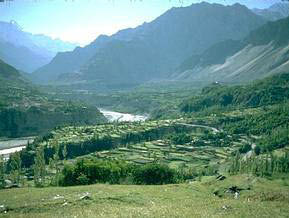 |
|
|
| ------------------------------------------------------------------------------------------------------------------------------------------------------------------ |
 |
· Emerald from Mingora, the main city of Swat. The |
|
| deposit discovered in 1958 was closured and monopolized |
|
| by the government, it is what compelled certain inhabitants |
|
| residing in the neighborhood to dig under their house |
|
| in order to research the prohibited treasure. |
TECTONIC CONTROL OVER EMERALD MINERALIZATION IN SWAT. |
|
|
| It is in the Swat valley that Alexander of Macedon fought |
Emerald and chromian tourmaline occur in carbonate-talc/ |
| and won some of his major battles before crossing over |
serpentine/chlorite rocks, carbonate-bearing talc schists, |
| to the plain of Pakistan. |
and associated quartz veins near Mingora, Charbagh, and |
|
Let us note that the emerald was known for a long time
|
Shangla. The rocks are altered ultramafics found in a |
|
in this valley, thanks to an analysis on a stone of a
|
discontinuous belt of volcanic, volcano-sedimentary, and |
|
Gallo-Roman ear-ring, witch shown that this emerald
|
sedimentary rocks that have undergone high P-low T |
|
originated in of the mines located in the Swat valley.
|
metamorphism. |
|
This thanks to the measurement of the report/ratio of
|
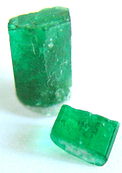
This is at the occasion of one of our visits in the valley, that some children tolled us that they found some fragments of emerald in the Swat river.
|
|
concentration of the isotopes 18O and 16O.
|
| Indeed, the isotopic composition out of oxygen of this |
| precious stone is dependent on that of the rock where |
| it crystallized. |
| |
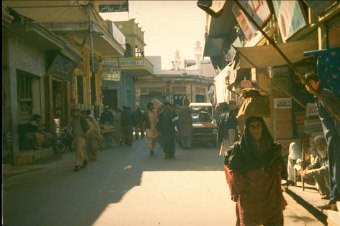 |
|
|
 · Central street of Mingora. · Central street of Mingora. |
|
|
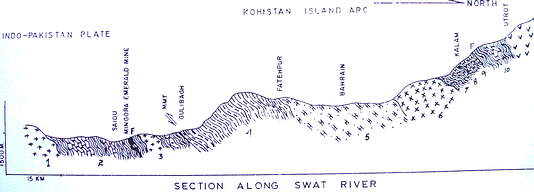 |
| --------------------------------------------------------------------------------------------------------------------------------------------------------------------- |
|
|
| Blue-green tourmaline from Kunar valley, Afghanistan. |
 |
Namak Mandi, old Peshawar, on the road to Afghanistan. |
|
|
|
©  All of the pictures on this website have been shot by gggems.com Text written by Alain Darbellay. All of the pictures on this website have been shot by gggems.com Text written by Alain Darbellay. |
|